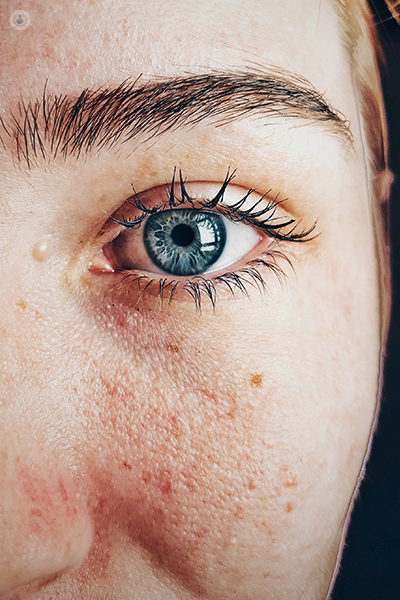Basal cell carcinoma: the most common skin cancer
Written by:Basal cell carcinoma (BCC) is the most common type of skin cancer and can make itself known in several ways. Fortunately, treatment is available. By reading this article by Dr Raj Mallipedi, a leading London dermatologist and specialist in skin cancer, you’ll understand how basal cell carcinoma manifests, what causes it and how it’s treated.

What is basal cell carcinoma?
Basal cell carcinoma (BCC) is the most common form of skin cancer. Fortunately, it’s usually only locally invasive – meaning it does not spread beyond the skin where it first appears. Such tumours show symptoms in a variety of ways depending on the subtype and may manifest as a pearly pink/red nodule, a red scaly patch, an ulcer or it could even have a scar-like appearance.
What causes basal cell carcinoma?
Basal cell carcinoma is most commonly a result of chronic sun exposure or repeated sunburn in fairer skinned individuals. However, some cases arise from inherited genetic conditions such as Gorlin's syndrome. Other risk factors include exposure to ionising radiation and immune suppression, either from disease or medication.
How is basal cell carcinoma treated?
There are many different forms of treatment. These depend on various factors:
- The site of the basal cell carcinoma
- Its size
- Histological features (the cell behaviour on a microscopic level)
- Individual patient variables
Surgical excision is the most common treatment option but radiotherapy is employed where surgery is not appropriate. In higher-risk tumours where the margins (edges) of the tumours are difficult to define or where tumours recur following previous treatments, a specialised form of surgery known as Mohs micrographic surgery can be beneficial. (See Mr Mallipeddi’s articles on Mohs surgery - ‘ What you need to know about Mohs surgery and slow Mohs surgery ’ and ‘ How successful is Mohs surgery?’)
On the other end of the spectrum, even creams can be used for superficial lesions. Photodynamic therapy, which combines the use of cream and light, is another option for such low-risk tumours.
How dangerous is basal cell carcinoma?
Basal cell carcinomas tend to grow slowly but over time can ulcerate and bleed. Fortunately, they usually respond to treatment and are rarely life-threatening.
Can basal cell carcinoma go away on its own?
Basal cell carcinomas do not generally go away on their own. Sometimes, they may seem to be less prominent depending on the degree of skin inflammation around the tumour. However, it is important to note the tumour cells are often beneath the skin surface and not visible to the naked eye.
Dr Mallipeddi is trained and experienced in the latest treatments for skin cancer. Learn more about how he can help you – click here.

